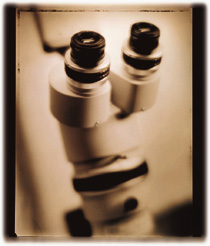Main Menu · Search · Current Issue · Contact · Archives · Centennial · Letters to the Editor · FAQs
 |
"if you ask a seventh grader what it takes to make a baby, 90 percent of them could come up with two of the three major ingredients: sperm and eggs," says Mitchell Rein, assistant professor of ob-gyn and reproductive biology at Harvard Medical School and chief of ob-gyn and director of women's services at Salem Hospital/North Shore Medical Center. "The third is a way for them to get together: the tubes."
What causes infertility? Sperm problems are the "most common and will be the major cause in 35 to 50 percent of all cases," he says. Egg or ovulation problems comprise 15 percent and tubal problems 15 to 20 percent of cases. Another 15 percent of couples have "unexplained infertility," and "about 25 percent of infertility cases have more than one factor--so these numbers don't have to add up to exactly 100 percent," he notes. Age also has "a strong impact on a couple's infertility, regardless of the etiology," he adds. Conventional treatments such as fertility drugs (often used in conjunction with IUI--intrauterine or "artificial" insemination) and surgery can help many of these couples, but not all.
Male infertility is easier to detect but more difficult to correct than female infertility. Normal sperm counts range from 20 million to 60 million cells per milliliter (one-fifth of a teaspoon) of semen. Anything below that means a low sperm count, the most common cause of male infertility. About half the cases of low sperm count are caused by varicoceles (varicose veins in the testicle), or blocked sperm ducts, often due to scarring from sexually transmitted diseases (STDs). Microsurgery can be effective for both, and fertility drugs may help the next most common cause: hormonal deficiency. All-out testicular failure can be caused by a range of traumas--including mumps, STDs, and injuries--and is more difficult to treat. Another 10 percent of infertile men have antibodies that destroy their sperm as soon as it's produced. Whatever the cause, IUI and ART are often employed to boost the chances of sperm reaching the egg.
In female infertility, ovulatory or endocrine problems account for about half of all cases. Common causes include failure of the hypothalamus to induce ovulation, polycystic ovarian disease, and premature ovarian failure. In luteal phase dysfunction, there is not enough progesterone after ovulation (the "luteal phase") to support the implantation of a fertilized egg. Oral contraceptives may also render a woman anovulatory after she has stopped taking the Pill. Many of these problems are treated with ovulation-inducing drugs plus IUI.
Obstructions within the reproductive system account for another 40 percent of women's infertility; the leading cause is pelvic inflammatory disease (PID). Twenty years ago, blocked fallopian tubes, pelvic adhesions, and scarring--which can all prevent the egg and sperm from connecting--caused only 25 percent of female infertility. But as men and women have become sexually active earlier and with more partners, the number of pelvic infections caused by sexually transmitted bacteria has multiplied. Barrier contraception protects a woman's reproductive system, but the IUD renders her up to 10 times more likely to contract PID. The second most common cause of obstructions is endometriosis: the blood-rich lining of the uterus escapes and grows on the ovaries or tubes, creating adhesions. Although microsurgery and laser surgery often restore blocked tubes, they do not always restore fertility, at which point couples turn to IVF.
Looming over all these factors is the factor of age. Aging decreases fertility in both sexes, but more dramatically in women. A woman under 30 has a 20 percent chance of becoming pregnant in any given month, but once over 40, her chances plummet to 5 percent. She begins her reproductive life with 300,000 eggs, but only a few thousand remain when she is in her forties. Older eggs do not fertilize as easily, do not respond as well to reproductive hormones, and have a higher number of chromosomal problems. Therefore, the risks of miscarriage, or of bearing a child with genetic disorders such as Down syndrome, increase steadily with age.
Infertility is diagnosed after a woman or a couple has tried to achieve pregnancy for a full year and failed, since it takes, on average, six months to conceive. According to some estimates in the popular press, there are 9 or 10 million infertile couples of child-bearing age in the United States--or 1 in 6 couples--and infertility is reaching "epidemic" proportions. But the National Center for Health Statistics contests this view, reporting that about 4.9 million women between the ages of 15 and 44 were infertile in 1988 (or about 1 in 12). These women represented only 8.4 percent of their age group; in 1965, the percentage of infertile women in the same age group was 11 percent.
The public perception that infertility rates are rising is due, in part, to extensive media coverage of new reproductive technologies and to the proliferation of fertility clinics (from 30 to 300) in the last decade. The huge cohort of baby boomers has also produced "a big bubble of childless women," as one reporter called it. The common practice of delaying child-bearing until couples are in their thirties (20 percent of U.S. women begin their families after age 35) increases the time it takes to conceive naturally, as well as the pressure to conceive quickly. And several international studies have reported dramatic declines in sperm counts, possibly due to environmental causes.
Main Menu ·
Search · Current Issue · Contact · Archives · Centennial · Letters to the Editor · FAQs
![]()